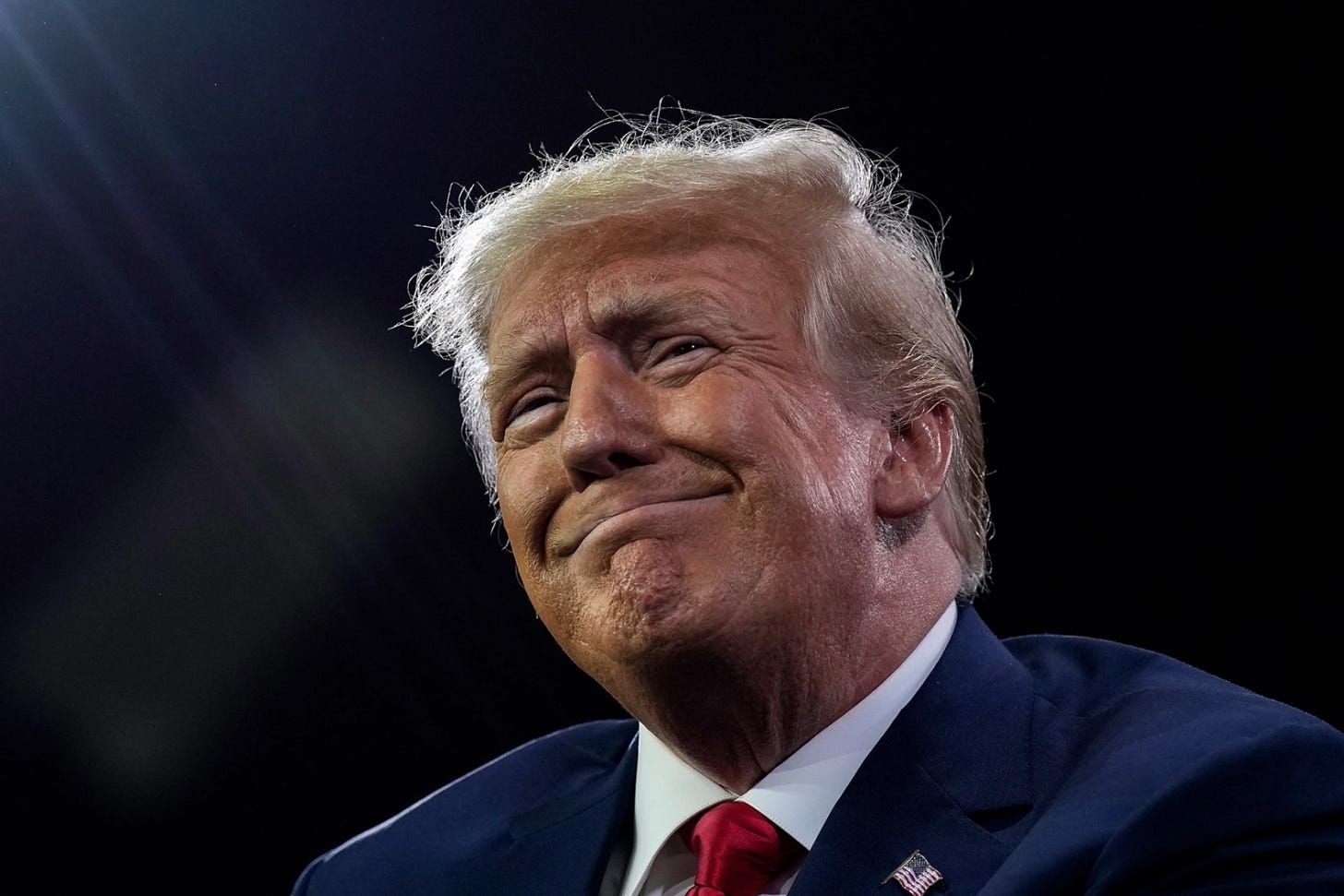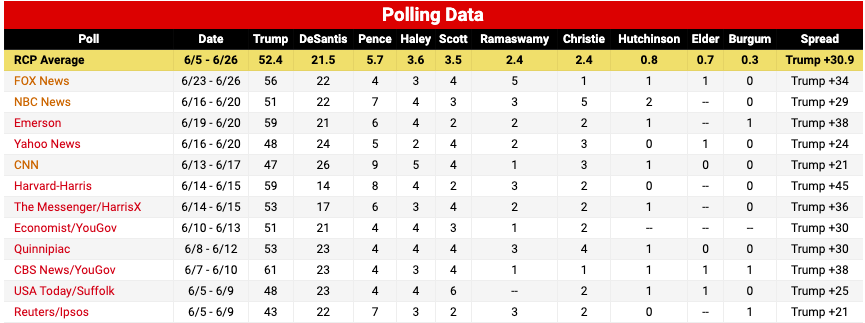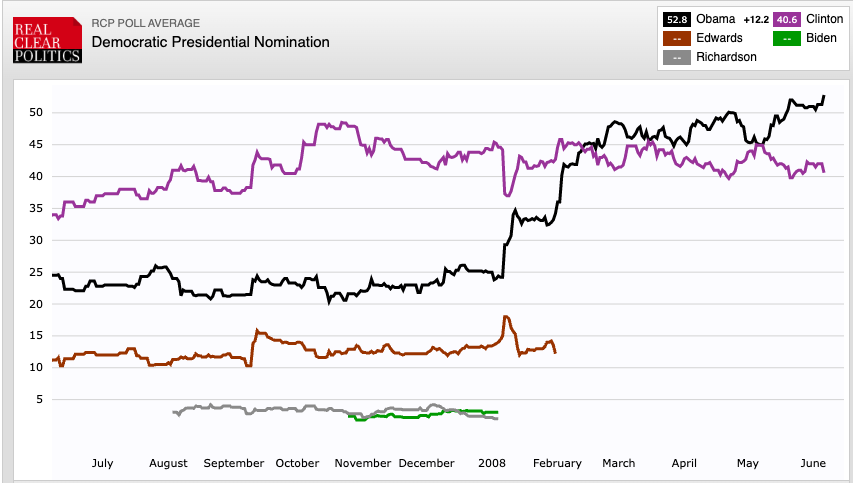We’re still months away from the first votes being cast in the 2024 Republican presidential race. But, already there are some whispers that the contest is effectively over before it started, with former President Donald Trump walking away with the nomination.
“Right now, in national polling, we are way behind,” Steve Cortes, a national spokesman for Florida Gov. Ron DeSantis’ super PAC, said Sunday. “I’ll be the first to admit that I believe in being really blunt and really honest. It’s an uphill battle.”
Which is true!
In a Fox News poll released recently, Trump took 56% to just 22% for DeSantis while no one else in the field cracked double digits. An NBC News poll has the race 51% for Trump to 22% for DeSantis.
In fact, Trump’s average lead, according to the Real Clear Politics polling average, is now over 30 points.
And what’s even more concerning — for DeSantis and the rest of the field — is that Trump’s lead (and vote share) have been steady for months now.
The last time DeSantis was within 15 points(!) of Trump was early March. Trump’s lead has not only widened but stabilized since that time.
Compare those numbers to where the 2008 Democratic race — between frontrunner Hillary Clinton and challenger Barack Obama — was at this time of the nominating calendar.
In early July 2007, Clinton held a 14-point lead over Obama. The largest her lead EVER got was 28 points in the fall of 2015.
And, unlike Obama, who was already showing signs of life in polling, DeSantis appears to be going in the wrong direction, with his numbers flat-lining even after his formal announcement.
The argument from the DeSantis team is that the numbers in early states like Iowa, New Hampshire and South Carolina look better for him.
The problem there is two fold: 1) There’s almost zero quality data coming out of Iowa, where DeSantis has to do well, at this point and 2) the eye test doesn’t seem to back up the notion that Trump is somehow weaker in early states.
On point #2, take this POLITICO report from a South Carolina rally Trump held over the weekend:
Taking over the movie-set-like Main Street of a town of 3,300 in the hills of South Carolina on Saturday, Trump put on a show of force not only in his stronghold of rural America, but in an early primary state where he remains dominant.
In front of a crowd local officials estimated may have reached 50,000, Trump barged onto the home-state turf of two of his primary opponents, Nikki Haley and Sen. Tim Scott. The size of Trump’s audience — and its fervor — was the latest ominous sign not only for them but for Florida Gov. Ron DeSantis, Trump’s top rival, who is desperately trying to peel off part of Trump’s base in this first-in-the-South primary state.
50,000! That is a stunning number — especially because it didn’t come from Trump’s campaign, which has a long habit of drastically overestimating his crowd sizes.
The reality of the primary process is this: The race is entering a period of summer stasis. Voters check out of politics — even more than usual — during the summer months as they travel and take time off from work.
Which means very little is likely to change in the race between now and Labor Day. And once we get to Labor Day, you have, effectively, three months before voters start voting. Which isn’t that long!
In short: It’s getting late pretty early in this race.
It’s not immediately clear to me either how DeSantis is going to make up ground on Trump. He appears to be working to paint himself as more conservative than the former president on LGBT issues, judges and abortion.
I am very skeptical that running to Trump’s ideological right will work in this race. Trump’s appeal — especially among those most conservative of voters — is far more tonal than it is issues-based. They don’t really seem to care what he has said in the past on issues; they just like that he is tough and willing to smack around Democrats, the media and, yes, even fellow Republicans.
It’s also not obvious to me that if DeSantis continues to stumble that someone else will pick up his mantle and run with it.
Tim Scott and Nikki Haley are both credible and serious candidates who appear to have generated little excitement behind their bids to date. Mike Pence, who is running third in most polling, is hated by the Trump base for not overturning the 2020 election — which is sort of a problem. Chris Christie has built a bit of momentum with his relentless critique of Trump but seems hard-capped because so many Republicans say they simply will not vote for him under any circumstances.
Everyone in the race — other than Christie — seems, at some level, to be waiting for Trump to implode so that they can pick up the pieces of his voting coalition. No one wants to be too mean to Trump for fear that if/when he drops out, they will have unnecessarily alienated his voters.
But, here’s the thing: Trump ain’t leaving the race. He’s said as much — bluntly! There’s no scenario I can imagine where Trump gets out — not another indictment, not a conviction, nothing.
That’s especially true when the race looks like a coronation for him, which, increasingly, appears to be what’s happening.
I’ve been operating under the assumption for months now that Republican voters want a real race for their nomination and that if DeSantis isn’t the guy (and there are increasing signs he’s not) then they will land on someone else (Scott?) as a credible and serious challenger.
My theory on this has long been guided by Double Dribble, the seminal basketball video game in the 90s. In that game, no matter how many points you were ahead by in the 1st half, the computer always managed a super human (ahem) comeback in the 2nd half. You couldn’t make any shots and the computer made everyone. And then, suddenly, it was a two-point game with 30 seconds left.
Voters, I have always thought, are sort of like that computer. They like close contests. They like people fighting like crazy to win. They like drama.
I am beginning to rethink that theory as just another rule of the game that doesn’t apply to Donald Trump. He is running away and hiding at the top of this race — and no one below him seems to have a credible case to make against him.
I would never declare a race over this many months before voters actually vote. Stuff changes — always. But I will say that Trump is the prohibitive frontrunner in this race in a way I never thought he would be even 6 months ago.







Although I realize that logic is often irrelevant when a Trump candidacy is the topic, let's try a bit of logic here, anyway. Let's logically assume that within the next several months there will be a few dozen more felony charges brought against Trump and/or the Trump legal team. Let's logically assume that GOP primary voters have already looked at DeSantis and concluded, let's be honest, DeSantis is NOT likeable at all. Let's also logically assume that the modern-day Republican Party -- build on hatred and racism -- will not turn to an African-American candidate as their big hope for 2024. And let's logically assume that we continue to have an economy with full employment, record unemployment and without the long-predicted, but not occuring, recession. So where does all of this leave the GOP at the beginning of 2024? And why do so many pundits have so much difficulty looking at this logic?
I wish the reporting on TFG's rallies would include the facts that a) he's doing fewer than he used to (gosh, I would love to know all the reasons why) and b) many of the attendees are die hard fans who attend many (if not all) of his events.
His fans (who still only get one vote each) follow him like the Dead Heads followed the Grateful Dead. They make the crowds large, but aren't representative of, say, his popularity in South Carolina.
And I, too, am waiting for his multiple indictments to have an effect. Maybe when he actually has to show up in court . . . ?